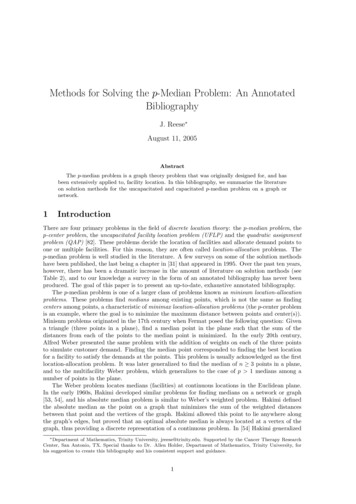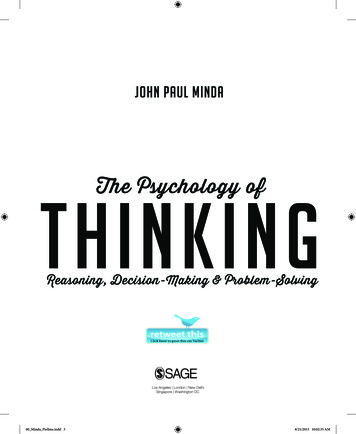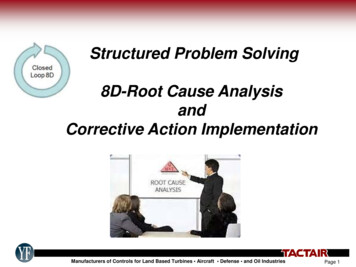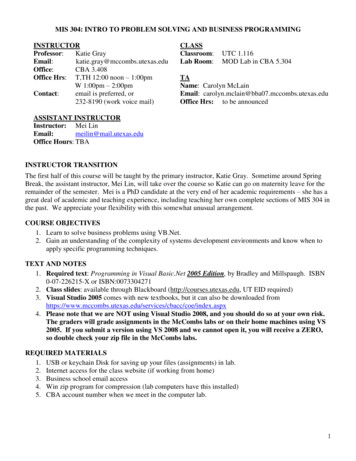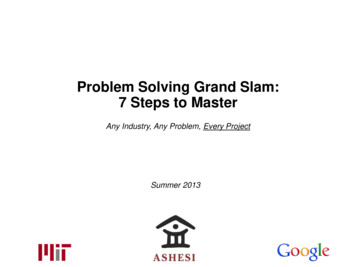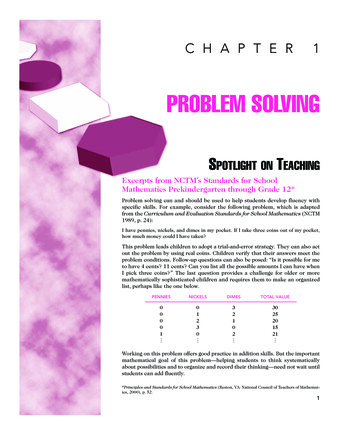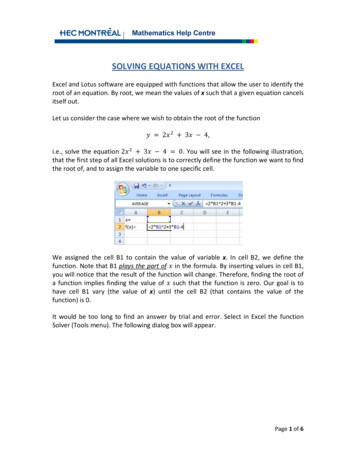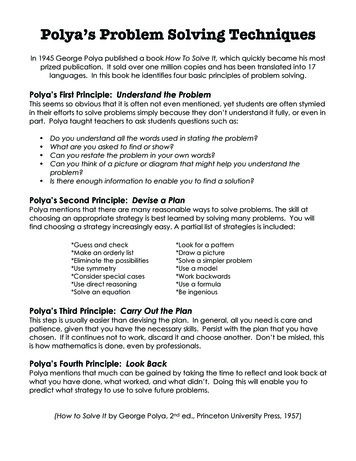
Transcription
Polya’s Problem Solving TechniquesIn 1945 George Polya published a book How To Solve It, which quickly became his mostprized publication. It sold over one million copies and has been translated into 17languages. In this book he identifies four basic principles of problem solving.Polya’s First Principle: Understand the ProblemThis seems so obvious that it is often not even mentioned, yet students are often stymiedin their efforts to solve problems simply because they don’t understand it fully, or even inpart. Polya taught teachers to ask students questions such as: Do you understand all the words used in stating the problem?What are you asked to find or show?Can you restate the problem in your own words?Can you think of a picture or diagram that might help you understand theproblem?Is there enough information to enable you to find a solution?Polya’s Second Principle: Devise a PlanPolya mentions that there are many reasonable ways to solve problems. The skill atchoosing an appropriate strategy is best learned by solving many problems. You willfind choosing a strategy increasingly easy. A partial list of strategies is included:*Guess and check*Make an orderly list*Eliminate the possibilities*Use symmetry*Consider special cases*Use direct reasoning*Solve an equation*Look for a pattern*Draw a picture*Solve a simpler problem*Use a model*Work backwards*Use a formula*Be ingeniousPolya’s Third Principle: Carry Out the PlanThis step is usually easier than devising the plan. In general, all you need is care andpatience, given that you have the necessary skills. Persist with the plan that you havechosen. If it continues not to work, discard it and choose another. Don’t be misled, thisis how mathematics is done, even by professionals.Polya’s Fourth Principle: Look BackPolya mentions that much can be gained by taking the time to reflect and look back atwhat you have done, what worked, and what didn’t. Doing this will enable you topredict what strategy to use to solve future problems.(How to Solve It by George Polya, 2nd ed., Princeton University Press, 1957)
1. Understand the Problem First. You have to understand the problem.What is the unknown? What are the data? What is the condition?Is it possible to satisfy the condition? Is the condition sufficient to determinethe unknown? Or is it insufficient? Or redundant? Or contradictory?Draw a figure. Introduce suitable notation.Separate the various parts of the condition. Can you write them down?2. Devising a Plan Second. Find the connection between the data and the unknown. Youmay be obligated to consider auxiliary problems if an immediateconnection cannot be found. You should obtain eventually a plan of thesolution.Have you seen it before? Or have you seen the same problem in a slightlydifferent form?Do you know a related problem? Do you know a theorem that could beuseful?Look at the unknown! Try to think of a familiar problem having the same ora similar unknown.Here is a problem related to yours and solved before. Could you use it?Could you use its result? Could you use its method? Should you introducesome auxiliary element in order to make its use possible?Could you restate the problem? Could you restate id still differently? Goback to definitions.If you cannot solve the proposed problem, try to solve first some relatedproblem. Could you imagine a more accessible related problem? Couldyou solve a part of the problem? Keep only a part of the condition, dropthe other part; how far is the unknown then determined, how can it vary?Could you derive something useful from the data? Could you think of otherdata appropriate to determine the unknown? Could you change theunknown or data, or both if necessary, so that the new unknown and thenew data are nearer to each other?Did you use all the data? Did you use the whole condition? Have youtaken into account all essential notions involved in the problem?3. Carrying Out The Plan Third. Carry out your plan.Carry out your plan of the solution, check each step. Can you see clearlythat the step is correct? Can you prove that it is correct?4. Looking Back Fourth. Examine the solution obtained.Can you check the result? Can you check the argument?Can you derive the solution differently? Can you see it at a glance?Can you use the result, or the method, for some other problem?
WARN!NGS!GNS!Recognize three common instructional moves that aregenerally followed by taking over children’s thinking.By Victoria R. Jacobs, Heather A. Martin, Rebecca C. Ambrose, and Randolph A. PhilippSTUDIOARZ/THINKSTOCKHwww.nctm.orgave you ever finished working with a child and realizedthat you solved the problem and are uncertain whatthe child does or does notunderstand? Unfortunately,we have! When engaging in a problemsolving conversation with a child, our goalgoes beyond helping the child reach a correct answer. We want to learn about thechild’s mathematical thinking, support thatthinking, and extend it as far as possible.This exploration of children’s thinking iscentral to our vision of both productiveindividual mathematical conversations andoverall classroom mathematics instruction(Carpenter et al. 1999), but in practice, wefind that simultaneously respecting children’s mathematical thinking and accomplishing curricular goals is challenging.Vol. 21, No. 2 teaching children mathematics September 2014Copyright 2014 The National Council of Teachers of Mathematics, Inc. www.nctm.org. All rights reserved.This material may not be copied or distributed electronically or in any other format without written permission from NCTM.107
1. Interrupting the child’s strategy2. Manipulating the tools3. Asking a series of closed questionsWhen teachers took over children’s thinkingwith these moves, it had the effect of transporting children to the answer without engagingthem in the reasoning about mathematicalideas that is a major goal of problem solving.We do not believe that any specific teachingmove is always productive or always problematic, because, to be effective, a teaching movemust be in response to a particular situation.However, because these three teaching moveswere almost always followed by the taking overof a child’s thinking, we came to view them aswarning signs, analogous to signs a motoristmight see when a potentially dangerous obstacle lies in the road ahead. By identifying thesewarning signs, we hope that teachers will learnto recognize them so that they can carefullyexamine these challenging situations beforedeciding how to proceed.108September 2014 teaching children mathematics Vol. 21, No. 2ERPRODUCTIONS LTD/THINKSTOCKIn this article, we use the metaphor of traveling down a road that has as its destination children engaging in rich and meaningful problemsolving like that depicted in the Common CoreState Standards for Mathematics (CCSSM)(CCSSI 2010). This road requires opportunities for children to pursue their own ways ofreasoning so that they can construct their ownmathematical understandings rather thanfeeling as if they are mimicking their teachers’thinking. Knowing how to help children engagein these experiences is hard. For example, howcan teachers effectively navigate situations inwhich a child has chosen a time-consumingstrategy, seems puzzled, or is going down apath that appears unproductive?Drawing from a large video study of129 teachers ranging from prospective teachers to practicing teachers with thirty-threeyears of experience, we found that even thosewho are committed to pointing students to therich, problem-solving road often struggle whentrying to support and extend the thinking ofindividual children. After watching teachers andchildren engage in one-on-one conversationsabout 1798 problems, we identified three common teaching moves that generally preceded ateacher’s taking over a child’s thinking:Three warning signsConsider the following interaction in whichPenny, a third grader, is solving this problem:The teacher wants to pack 360 books in boxes.If 20 books can fit in each box, how manyboxes does she need to pack all the books?Penny pauses after initially hearing the problem, and the teacher supports her by discussingthe problem situation, highlighting what she istrying to find:Teacher [T]: So, she has 360 books and 20 booksin each box. So, we’re trying to find how manyboxes 360 books will fill.Penny [P]: Hmm T: So, you have 360 books, right? And what doyou want to do with them?P: Put them in each boxes of 20.T: Boxes of 20; so you want to separate theminto 20, right?P: Mmm-hmm.T: Into groups of 20. So, what are you trying tofind?www.nctm.org
Warning! Even with thebest of intentions, someteacher efforts to movestudents’ thinking forwardcan actually stifle it.under it (see fig. 1). When Penny pauses brieflybefore writing the next number, the teacherinterrupts Penny’s strategy to introduce herown by asking, “Do you know how many timestwo goes into thirty-six?”Here we see the first warning sign: interrupting the child’s strategy. The teacher then picksup a pen and writes the problem 36 2 as thestandard division algorithm, and we see thesecond warning sign: manipulating the tools.Penny responds, “Twenty,” and the teacherinvites her to follow the steps to complete thealgorithm (e.g., “How many times does two gointo three?”) but then changes the conversation slightly to consider the original numbersin the problem, writing the division problem360 20 as the standard division algorithm.The teacher completes the first part of the algorithm for this problem herself and then guidesPenny through the rest of the steps by asking aseries of closed questions, requiring only agreement (“Mmm-hmm”) or short answers (e.g.,“Eight”)—illustrating the third warning sign:asking a series of closed questions.After discussing the problem situation,Penny develops an approach, writes 360, andstarts incrementing by twenties, writing 20 and40. At this point, she whispers, “It’s gonna taketoo long,” but the teacher encourages Pennyto continue by asking about her strategy. “Areyou counting by twenties? Is that what you’redoing there?”Penny confirms and resumes her strategy,writing multiples of 20 through 140. Then, fromthe beginning of her list of numbers, she makesa mark under each one, apparently tallying thenumber of boxes she has made so far. At theend of her list, she resumes her strategy by writing the next number, 160, and making a markwww.nctm.orgT: Do you know how many times 20 goes into160? [Penny does not respond.] Do you knowhow many times 2 goes into 16?P: Two times sixteen? Times?F IG URE 1P: Trying to find how many go in each—well,you already finded out that, but you need tofind how T: How many boxes, right?P: Right.T: So, you’re trying to find out how manygroups of 20 there are?P: Mmm-hmm.T: In 360?Penny’s strategy was to count by twenties.(a) She recorded each number, placed a mark under it, andthen tallied the marks.(b) When Penny paused,her teacher interrupted andintroduced a different approach.Vol. 21, No. 2 teaching children mathematics September 2014109
ALEXANDER BEDRIN/THINKSTOCKMANIPULTHE T O ATINGOLST: Well, if you go, how many 2s are in 16—so, 2,4, 6, 8, 10, 12, 14, 16 [writing the numbers whileshe counts by twos]. How many is that? [Theteacher points along the list of numbers whileshe counts aloud.] 1, 2, 3, 4, 5, 6, 7, 8, right?P: Mmm-hmm.T: So, 20 goes into 160, which is just [attaching]a zero. [The teacher points at the appropriatespot on the paper for Penny to write.]P: [writing] Eight.T: Mmm-hmm. Twenty times 8. Yes, ’cause 20times 8 is 160, so this would be an 8, right?P: Mmm-hmm.With the answer of 18 now written, the teacherchecks Penny’s understanding of what theyhave just done with another series of closedquestions.T: So, how many boxes do we need? [WhenPenny does not respond, the teacher points tothe answer of 18.] What does this represent? Doyou know?P: Eighteen.T: Mmm-hmm, but do you know like in thisproblem how we would P: Eighty-one? I mean T: Do you know what this [18] represents? Likethis 20 represents the 20 books that can fit ineach box.P: Mmm-hmm.T: And 360 represents the total number ofbooks. So, 18 represents P: The boxes.T: How many boxes?P: Eighteen.T: There you go. Does that make sense?P: Mmm-hmm.T: ’Cause you just have to divide them into thedifferent boxes.In this example, the teacher began theinteraction with moves that supported Penny’sthinking (e.g., probing her initial strategy and110September 2014 teaching children mathematics Vol. 21, No. 2understanding of the problem) and then helpedher reach a correct answer. However, we sharethis illustration because it also highlights thethree moves that should serve as warning signsbecause they often, and in this case did, lead totaking over the child’s thinking: interrupting thechild’s strategy, manipulating the tools, and asking a series of closed questions.1. Interrupting the child’s strategyWhen a teacher interrupts a child’s strategyto suggest a different direction, the teacher’sthinking becomes privileged because the child’sthinking—which was “in process”—is halted.This interruption may involve talking over achild who is already speaking, or jumping inwhen a child is working silently. In both cases,this warning sign generally accompanies thehazard of breaking the child’s train of thought—the child may struggle to regain momentumin solving the problem or may lose the threadof his or her idea altogether. Additionally, theteacher may introduce a strategy that does notmake sense to the child. In the example above,Penny had a viable strategy and was in theprocess of executing it when her strategy wasinterrupted with a different approach proposedby her teacher. Perhaps the teacher thoughtthat Penny’s strategy of counting up by twentieswould take too long or that she would struggletoo much to find each multiple. Or perhaps theteacher had expected (or hoped) that Pennywould use the standard division algorithm. Inany case, Penny had no opportunity to return toher original strategy and complete it. Furthermore, Penny was making sense of the problemsituation with her original strategy, but thissense making disappeared when the teacherintroduced the algorithmic strategy.In our larger study, we observed that somechildren, like Penny, had viable strategies forsolving their problems, whereas other children’sstrategies and intent were unclear. However,in all cases, their thinking was “in process” inthat they were writing, counting aloud, movingfingers while working silently, and so on. Theteachers’ interruptions sometimes introducedcompletely new strategies (as in Penny’s case)and other times pushed children to engagewith their partial strategies in specific ways thatchanged children’s problem-solving approachesand were inconsistent with their reasoning. Inwww.nctm.org
each case, teachers risked impeding or abortingchildren’s thinking by inserting and privilegingtheir own ideas while halting the children’s inprocess thinking.2. Manipulating the toolsTABL E 1Another warning sign teachers should notice iswhen they visibly take control of the interactionby manipulating the pen, cubes, or other tools.In the example above, Penny had a writtenrecording of her strategy in progress at the top ofthe page when the teacher’s writing of the standard division algorithm shifted Penny’s focus tothe teacher’s strategy. The teacher then retainedcontrol of the pen for much of the interactionwhile she wrote and talked her way throughthis algorithm. In doing so, she changed therepresentation of the problem from Penny’swritten recording of the multiples of twentyand the accompanying tallying of boxes to anapproach that was abstract for Penny and nota good match for her thinking—as evidencedin Penny’s struggles to make sense of both thecalculation and the result.In our larger study, we observed teachers writing things or moving manipulatives,although sometimes they did so without changing the course of conversations so completely.However, taking over tools was inherently riskybecause doing so sent children a message aboutwho owned the thinking. Teachers also riskedaltering problem representations to representations unclear to children—teachers and childrenmay be thinking differently, even when lookingat the same manipulatives or written representations (Ball 1992).3. Asking a series of closed questionsThis third warning sign highlights a situationthat may begin nonhazardously—when theteacher asks a question with a simple and oftenobvious answer. The danger arises when thisquestion is followed by another and another andanother such question. The net effect of a seriesof closed questions is that the problem getsbroken down for the child into tiny steps thatrequire minimal effort and little understandingof the problem situation. Such was the case forPenny after the standard division algorithm wasintroduced because the teacher asked questionsthat required little more than Penny’s agreement(“Mmm-hmm”). Penny did not have to thinkabout the underlying ideas of division, and theproblem-solving endeavor was instead reducedto following directions.In our larger study, we observed teachersgiving directions that were sometimes phrasedas questions and other times as steps to follow. In either case, when the answer was finallyreached, the children had often forgotten theBecome aware of teaching moves and of potentially taking over students’ thinking.Warning signs for taking over children’s thinkingWarning signsQuestions to consider before proceedingPotential alternative moves1. Interruptingthe child’sstrategyDo I understand how the child is thinking and willmy ideas interfere with that thinking? Slow down: Allow the child to finishbefore intervening.Will the child be able to make sense of my ideas?2. Manipulatingthe toolsWill the child still be in control of the problem solving? Encourage the child to talk about hisor her strategy so far.3. Askinga seriesof closedquestionsWill my questions be about the child’s thinking ormy thinking?www.nctm.orgWill my problem representation make sense tothe child?Will the child still have an opportunity to engagewith substantive mathematics, or will my questionsprevent him or her from doing so? Ask questions to ensure that thechild understands the problemsituation and how the strategyrelates to that situation. Ask whether trying another tool orstrategy would help.Vol. 21, No. 2 teaching children mathematics September 2014111
CLOSEDSTUDIOARZ/THINKSTOCKoriginal goal and wererarely able to relate thesolution to the problem situation. Wesaw this confusionwith Penny whenshe guessed,“Eighty-one?”i n re s p o n s eto a questionabout howmany boxeswere needed. This apparent stab in the dark wasa signal that the teacher’s sequence of closedquestions did not help Penny make sense of theteacher’s algorithmic strategy or relate it to theoriginal problem.Heeding the warning signsThe warning signs exemplified in Penny’sinteraction arose often in our study, sometimesin isolation and sometimes as a set. So, whatcan teachers do? When possible, we encourageteachers to heed the warning signs by choosing alternative moves that are more likely topreserve children’s thinking. The questions intable 1 are designed to help teachers consideralternative moves. We do not suggest that thesealternative moves are foolproof—unfortunately,no moves are. Engaging with children’s thinkingis a constant negotiation, fraught with trial anderror, as teachers work to find ways to elicit andrespect children’s thinking while nudging thatthinking toward reasoning that is more sophisticated. However, in analyzing our data, we werestruck with how often the three warning signswere unproductive in achieving this goal, thusprompting us to consider alternative moves.For example, how might the interactionhave been different if Penny had not beeninterrupted and had been able to complete herinitial strategy? The teacher could have probedPenny’s completed strategy, validating and eliciting her ways of thinking about the problem.If the teacher still wondered about efficiency,she might have asked if Penny could think ofanother way of solving the problem, perhapsin a way that was more efficient. This approachwould have built on Penny’s ways of thinkingabout the problem while still preserving thegoal of efficiency. Alternatively, if the teacher didchoose to suggest the division algorithm, she112September 2014 teaching children mathematics Vol. 21, No. 2could have left Penny in control of the pen andposed some open-ended questions to explorePenny’s understanding of the algorithm and itsconnection to the problem situation. Anotheroption would have been to ask Penny to consider efficiency while she was still solving theproblem with her original strategy. After Pennyhad completed 160 books (8 boxes) by counting by 20s, the teacher could have asked her toreflect on what she had done so far and if thatwork could help her proceed more quickly. (Thisquestion might prompt Penny to recognize thatdoubling 160 books [and 8 boxes] would be closeto the needed 360 books, but she would alsohave the option of continuing with her originalstrategy.) Although there is no perfect move inany situation, these types of alternative movesmight have increased the likelihood that theteacher would have supported and extendedPenny’s thinking without taking over that thinking. (See Jacobs and Ambrose [2008–2009] formore on alternative moves.)Are these moves ever productive?Our data convinced us that the warning signswere generally unproductive moves, but wewondered if these same moves could ever beproductive. After all, teaching moves need tobe considered in context because the samemove can be productive in one situation butunproductive in another. We found that thethree warning signs were occasionally usedproductively but, to us, they almost seemed likedifferent moves because, although they lookedsimilar on the surface, they were coupled withthe preservation of children’s thinking.For example, teachers sometimes productively interrupted a child going far off track orengaging in an extremely inefficient strategyby discussing with the child how he or she wasthinking. This move was not, as we saw withPenny, used to immediately suggest a different direction but instead deepened the child’s(and teacher’s) understanding of how the childwas thinking about the problem. Similarly,teachers sometimes productively manipulatedthe tools to help organize the workspace byremoving “extra” cubes after ensuring that theywere considered “extra” by the child (versus,for example, removing cubes to ensure that thecorrect quantities were represented). This moveprovided some organizational scaffolding whilewww.nctm.org
preserving the child’s way of thinking about theproblem. Finally, teachers sometimes productively asked a series of closed questions to checkon their understanding of a child’s strategy. Thismove kept the focus on the student’s thinkingby putting the child in position to confirm ordeny what he or she had already done, said,or thought. Thus, we are not suggesting thatthe three warning signs can never be used productively. However, our data overwhelminglyshowed that these moves typically led to takingover children’s thinking and thus should be usedwith caution.Good intentionsAll four authors have had the experience of solving a problem for a child without gaining anyidea what the child does or does not understand.We always begin these interactions with goodintentions, but other pressures (e.g., shortnessof time) or goals (e.g., desire to see the child usea more sophisticated strategy) often derail ourefforts. Our data also showed that taking over achild’s thinking was not linked to any particulartone or interaction style. In other words, in anygiven situation, any of us can be tempted to takeover a child’s thinking.In summary, avoiding the impulse to take overa child’s thinking in one-on-one conversations(either inside or outside the classroom) is challenging. We also recognize that the task becomeseven more challenging in social situations likesmall-group work or whole-class discussions.Nonetheless, in all these instructional situations,the same goals exist: eliciting, supporting, andextending children’s thinking. Further, the movesidentified as warning signs are likely to thwartefforts to achieve these goals because childrenget transported to the answer without actuallyengaging in problem solving. In identifying thewarning signs, our hope is that teachers will bemore likely to pause and consider alternativemoves to avoid the dangers of taking over children’s thinking. As a first step, we invite readersto go online (see the More4U box to the right) topractice recognizing these warning signs in aninteraction with a first grader.R EFER E N CE SBall, Deborah Loewenberg. 1992. “Magical Hopes:Manipulatives and the Reform of Math Education.”American Educator 16 (2): 16–18, 46–47.www.nctm.orgCarpenter, Thomas P., Elizabeth Fennema,Megan Loef Franke, Linda Levi, and SusanB. Empson. 1999. Children’s Mathematics:Cognitively Guided Instruction. Portsmouth,NH: Heinemann.Common Core State Standards Initiative (CCSSI).2010. Common Core State Standards forMathematics. Washington, DC: NationalGovernors Association Center for BestPractices and the Council of Chief State SchoolOfficers. th Standards.pdfJacobs, Victoria R., and Rebecca C. Ambrose.2008–2009. “Making the Most of StoryProblems.” Teaching Children Mathematics 15(December/January): 260–66.This research was supported in part by agrant from the National Science Foundation(ESI0455785). The opinions expressed in thisarticle do not necessarily reflect the position,policy, or endorsement of the supporting agency.Victoria R. Jacobs,vrjacobs@uncg.edu,is a mathematicseducator at theUniversity of NorthCarolina at Greensboro. Heather A.Martin, hmartin@ncbb.net, andRebecca C. Ambrose,rcambrose@ucdavis.edu, are mathematics educatorsat the University of California–Davis. Randolph A.Philipp, rphilipp@mail.sdsu.edu, is a mathematicseducator at San Diego State University in California.They all collaborate with teachers to explore children’smathematical thinking and how that thinking caninform instruction.Download one of the freeapps for your smartphoneto scan this code, or go towww.nctm.org/tcm067 toaccess an appendix.Vol. 21, No. 2 teaching children mathematics September 2014113
All Means ALLSave the Date!Equity:Washington DC April 22–25, 2009NCTM 2009 AnnualMeeting & ExpositionVisit www.nctm.org/washingtondc for the most up-to-date information.The NCTM 2009 AnnualMeeting and Exposition inWashington D.C. will bethe mathematics teachingevent of the year. This is oneprofessional developmentopportunity you can’t afford tomiss. Conference attendees will: Learn from more than 800presentations in all areas ofmathematics Network with other educatorsfrom around the world Explore the NCTM ExhibitHall and experience the latestproducts and services Develop your mathematicsresource library with booksand products from theNCTM Bookstore Enjoy Washington D.C.and all the nation’scapitol has to offer
Making the Most ofHonoring students’ solutionapproaches helps teachers capitalizeon the power of story problems.No more elusive train scenarios!By Victoria R. Jacobs and Rebecca C. AmbroseVictoria R. Jacobs, vjacobs@mail.sdsu.edu, is a mathematics educator at San Diego StateUniversity in California. Rebecca C. Ambrose, rcambrose@ucdavis.edu, is a mathematics educator at the University of California–Davis. They collaborate with teachers to explore children’smathematical thinking and how that thinking can inform instruction.260Story problems are an important component ofthe mathematics curriculum, yet many adultsshudder to remember their own experienceswith them, often recalling the elusive train problems from high school algebra. In contrast, researchshows that story problems can be powerful tools forengaging young children in mathematics, and manystudents enjoy making sense of these situations(NCTM 2000; NRC 2001). Honoring children’sstory problem approaches is of critical importance sothat they construct strategies that make sense to themrather than parrot strategies they do not understand.To explore how teachers can capitalize onthe power of story problems, we chose to studyTeaching Children Mathematics / December 2008/January 2009Copyright 2008 The National Council of Teachers of Mathematics, Inc. www.nctm.org. All rights reserved.This material may not be copied or distributed electronically or in any other format without written permission from NCTM.Photograph by Rebecca C. Ambrose; all rights reservedStory Problems
teacher-student conversations in problem-solvinginterviews in which a K–3 teacher worked one-onone with a child. The skills needed for productiveinterviewing are the same as those needed in theclassroom: Teachers must observe, listen, question,design follow-up tasks, and so on. We focused ourinvestigation on interviews because interviews isolate these important teacher-student conversationsfrom other aspects of classroom life.Supporting and ExtendingMathematical ThinkingAfter analyzing videotaped problem-solving interviews conducted by 65 teachers interviewing 231children solving 1,018 story problems, we identifiedeight categories of teacher moves (i.e., intentionalactions) that, when timed properly, were productive in advancing mathematical conversations. Weseparately considered (a) the supporting moves thata teacher used before a student arrived at a correctanswer and (b) the extending moves that a teacherused after the child gave a correct answer. We wantto be clear that the eight categories of teacher moveswe present are not intended to be a checklist thata teacher executes on every problem. Instead, weconsider these moves to be a toolbox from which ateacher can draw, after considering the specific
The teacher wants to pack 360 books in boxes. If 20 books can fit in each box, how many boxes does she need to pack all the books? Penny pauses after initially hearing the prob-lem, and the teacher supports her by discussing the problem situation, highlighting what she is trying to find: Teacher [T]: So, she has 360
